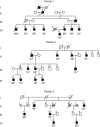New disease gene location and high genetic heterogeneity in idiopathic scoliosis
- PMID: 21407261
- PMCID: PMC3172921
- DOI: 10.1038/ejhg.2011.31
New disease gene location and high genetic heterogeneity in idiopathic scoliosis
Abstract
Idiopathic scoliosis (IS) is a spine disorder of unknown origin with 1.5-3% prevalence in the general population. Besides the large multifactorial-form sample of IS, there is a good evidence for the existence of a monogenic subgroup in which the disease is inherited in a dominant manner. However, results from literature suggest a strong heterogeneity in the locations of the mutated genes. Using a high-resolution genome-wide scan, we performed linkage analyses in three large multigenerational IS families compatible with dominant inheritance including 9-12 affected members or obligate carriers. In two of these families, our results suggested intra-familial genetic heterogeneity, whereas, in the other, we observed a perfect marker disease co-segregation in two regions at 3q12.1 and 5q13.3. We can state that one of these two locations is a novel IS disease gene locus, as the probability of having this perfect co-segregation twice by chance in the genome is very low (P=0.001). Lastly, in all three families studied, linkage to the previously mapped dominant IS loci on chromosomes 19p13.3, 17p11.2, 9q34, 17q25 and 18q is unlikely, confirming that there is a high genetic heterogeneity within the subgroup of dominant forms of IS.
Figures

References
-
- Rogala EJ, Drummond DS, Gurr J. Scoliosis: incidence and natural history. A prospective epidemiological study. J Bone Joint Surg Am. 1978;60:173–176. - PubMed
-
- Shands AR, Jr, Eisberg HB. The incidence of scoliosis in the state of Delaware; a study of 50 000 minifilms of the chest made during a survey for tuberculosis. J Bone Joint Surg Am. 1955;37-A:1243–1249. - PubMed
-
- Kane WJ. Scoliosis prevalence: a call for a statement of terms. Clin Orthop Relat Res. 1977;126:43–46. - PubMed
-
- Bonaiti C, Feingold J, Briard ML, Lapeyre F, Rigault P, Guivarch J. Genetics of idiopathic scoliosis. Helv Paediatr Acta. 1976;31:229–240. - PubMed
-
- Kesling KL, Reinker KA.Scoliosis in twins. A meta-analysis of the literature and report of six cases Spine (Phila Pa 1976) 1997222009–2014.discussion 2015. - PubMed
Publication types
MeSH terms
LinkOut - more resources
Full Text Sources
Other Literature Sources
Medical

